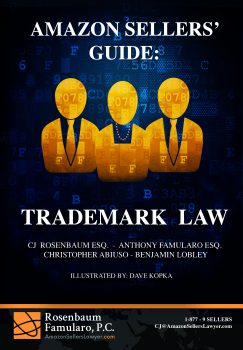
Amazon Sellers’ Guide: Trademark Law
By: CJ Rosenbaum Esq., Anthony Famularo Esq., Christopher Abiuso, and Benjamin Lobley
Chapter 2: The Filing Process ……….. 13
I. Introduction ……….. 13
II. Specimen and Declaration of Use ……….. 14
III. Examination ……….. 17
V. Continued Use ……….. 20
VI. Intent to Use ……….. 22
VII. Madrid Protocol ……….. 24
Chapter 2: The Registration Process
I. Introduction

The application for federal registration of a trademark with the USPTO is fairly simple. The process is primarily based on the federal statutes and regulations on trademarks.
CJ’s Side Note: It is crucial to register your trademark to protect your product from being infringed upon. Without registering the trademark, your ability to enforce your intellectual property rights is limited to your geographic area. In contrast, if you register with the USPTO, your trademark will be extended to the entirety of the US.
There are three methods Sellers can base their trademark application on:
(1) actual use of the mark in commerce;
(2) actual intent to use the mark in commerce; or
(3) a foreign application for registration, or a foreign registration, of the mark.[1]
There are separate applications with different principles for each ground.[2] Due to the similarity of the registration processes, it can be assumed that, unless otherwise specified, the text of this chapter discusses the registration process when the trademark has already been in commercial use.
II. Specimen and Declaration of Use
Whether the Seller is applying to register a trademark already in use or a trademark which will eventually be put into use, the “specimen” will be submitted at the very beginning of the registration process. The specimen is a drawing or representation of the mark which the Seller wishes to register.
Ultimately, this specimen should:
(1) accurately display the mark;
(2) show the association between the mark and the goods; and
(3) describe how the mark will be used in commerce.[3]
The following may help in determining what would be acceptable forms of specimens:
Acceptable Specimens:
- Tags or labels affixed to the goods of the container for the goods.
- Stampings on the goods or on a container.
- Instruction sheets packaged with the goods.
- Screen captures showing the mark displayed with the goods.
Unacceptable Specimens:
- Advertising
- Invoices
- Price-lists
- Business letterhead
There are several points in the registration process where Sellers must file a document which swears that he or she is actually using the trademark in commerce. This document is called an affidavit or declaration of use or continued use. Failure to provide the declaration will either result in a rejection of the registration at the onset of the process or, in the case of the declaration of continued use, cancellation of the Seller’s registered trademark.[4]
This section of the chapter will deal with the declaration of use, which occurs after the mark has been used in commerce but before the mark has been registered. For information regarding the affidavit of continued use, which is submitted after the registration has been granted at frequent intervals, please read ahead to Section IV of this chapter.
The declaration of use is one of the first documents to be submitted in the registration process to the USPTO. In the declaration, the applicant will be asserting and confirming that: (1) he or she is the owner of the trademark to be registered; (2) the mark is actually being used in the field of commerce specified in the application; (3) no other individual or business has the right to use the particular mark in commerce; (4) the specimens (discussed later) which are submitted with the declaration are accurate in how they portray the mark being used with the product; (5) the facts in the application are accurate and truthful; and (6) all statements made in the application are, to the applicant’s knowledge, truthful.[5] These declarations do not require applicant Sellers to investigate or research whether another has a conflicting trademark, nor does it require knowledge if the mark in question is registered in another country. These are not grounds for disqualifying the application since the boundary of being registered with the USPTO is the U.S. border.[6] However, any prior knowledge held while making this declaration of another Seller having rights to a sufficiently similar mark may be considered to be fraud against the USPTO, which would be considered a federal crime.[7]
Anthony’s Advice: Although the words “federal crime” might be scary, they are more of a deterrent against possible trademark infringers. As long as you present yourself honestly and to the best of your ability, you will be fine since it is not your responsibility to go out of your way to research others with potentially similar marks. Besides, since you will most likely be submitting your declaration through and with the aid of an experienced intellectual property law firm, you will have more than enough help in correctly submitting your declaration of use.
III. Examination

Once the declaration and specimen have been submitted to the USPTO, the application will be examined by an “examiner.” An examiner is an attorney employed by the USPTO. It usually takes about three months for an examiner to assigned to an application.[8] The examiner will review the trademark application for accuracy and applicability.[9] During examination, the examiner will review the Official Gazette (“Gazette”), a collection of registered trademarks, to determine if there is a confusingly similar mark already registered with the USPTO.[10] If such a confusion-inducing similar mark is discovered, the examiner will contest or outright reject the application.[11]
There are other reasons for which the examiner may reject or contest the application, such as a lack of distinctiveness; this is an issue which will be discussed more in depth later in this book. Further, while the Gazette is also discussed later in this book, all that must be understood for now is that the Gazette is a collection of all trademarks registered with the USPTO.[12]
If the examiner determines that there are contestable aspects of the trademark application, he or she may initiate an “office action” to block registration.[13] An office action is a preliminary rejection of the application. Office actions are directed at whatever the examiner deems most offending, whether it is a preexisting mark in the Gazette or a lack of distinctiveness.[14] During this contention, the examiner will support his or her claim about the mark’s lack of registrability similar to any normal court action. The applicant will have six months to respond to the office action.[15] Legal counsel is highly recommended in this period of time to support the Seller’s mark against the contentions raised by the examiner.
If the examiner finds no issues with the trademark application, or the Seller defeats the office action, the examiner will place the mark into the Gazette.[16] After this publication, there follows a period of 30 days, during which third parties who believe they will be injured by the publication may file an opposition.[17] Assuming there is no opposition, or the applicant is able to defeat any opposition which is filed, the registration will be official.
IV. Continued Use
After a trademark has been successfully registered with the USPTO, the Seller must file an affidavit claiming the continued use of the mark five years after registration.[18] After, a declaration of continued use must be submitted at every 10-year anniversary of the registration.[19] Failing to submit such declarations in a timely matter may lead to the cancelation of the trademark.[20]
The declaration must include a certified statement providing evidence of use in commerce or excusable nonuse of the trademark within the period designated in the Act.[21] It must also include:
(1) the U.S. registration number;
(2) the fee required for each class that the declaration covers;
(3) the grade period surcharge per class; and
(4) if a fee is submitted for a multiple-class registration, it must cover all the classes.[22]
If it does not cover all the classes and does not specify which class the fee should cover, the USPTO will issue a notice requiring either a submission of the additional fees or to clarify to which class the fee should be applied.[23]
The declaration must specify the nature of the goods or services that the trademark is for and how they are used in commerce. If it is not in use, the declaration must state when the use in commerce stopped and when the use is expected to resume.[24] Furthermore, it must assert the special circumstances that excuse the nonuse and state that the trademark was not abandoned.[25] Missing the date to file the declaration of continued use can have the potentially disastrous consequence of having your trademark registration cancelled; so, it should certainly never be overlooked.
V. Intent to Use
When the mark has not yet been used in commerce, a seller can apply for the mark to be filed if they have a genuine intent to use the mark in commerce.
CJ’s Side Note: The Lanham Act defines commerce as “all commerce that can be regulated by Congress.” In other words, your mark must be used in interstate commerce. If you only plan to conduct business solely on a statewide level, it may not amount to a genuine intent to participate in interstate commerce and will prohibit you from getting your trademark federally registered.
Sellers who file an intent to use (“ITU”) do not necessarily need to have their trademark to be in use before beginning the registration process.[26] Instead, the Seller must show that their mark has entered commerce at one of three points in the registration process: (1) before the application has been approved by the examiner; (2) within six months of filing the ITU; and (3) within one of the three six-month extensions available to the applicant.[27]
With an ITU application, Sellers gain priority rights in a trademark, but only if they actually use the mark in commerce at a later date.[28] Once an ITU application is filed, any subsequent users of the trademark will be given constructive notice of the contingent trademark.[29] The Seller who has filed an ITU application has priority of rights to the mark, even if the junior user begins using the mark first.[30] In other words, the priority date will relate back to the initial day that the Seller submitted the ITU application, not the day on which the Seller finally uses the trademark in commerce. In order to complete the registration process, Sellera must file an amendment to allege use or a statement of use after being given a notice of allowance.[31]
CJ’s Tip: Since the priority date of an ITU relates back to the date you file the ITU, instead of when you actually put the mark into commercial use, it is the best decision to file an ITU immediately after you decide to design and utilize a trademark. Any applicant who tries to register a similar mark in the time you develop the mark will be blocked from fully registering, unless you fail to actually put the mark into use within the allotted time.
VI. Madrid System
The international protection of trademarks is based on the Madrid System, which is governed by the World Intellectual Property Organization (“WIPO”) and is comprised of 117 member nations. There are two registration systems within the Madrid System: (1) the Madrid Agreement and (2) the Madrid Protocol.[32] The United States is a signatory only of the Madrid Protocol, meaning U.S. sellers can only register their trademark under the rules of the Madrid Protocol if registering abroad.[33] After obtaining a basic mark, an applicant may then file a Form MM2 international application through the Madrid System via his or her Office of origin.[34] If an international application designates the United States, the applicant must then file Form MM18.[35] The applicant’s Office of origin will then file Form MM2 and, if applicable, Form MM18 on behalf of the applicant with WIPO, who will examine the application, register the mark in the International Register, and publish the mark in the Gazette of International Marks.[36] The examination may take 12 to 18 months, after which the scope of protection will be determined.[37] The outcome of registering through the Madrid Protocol is that the Seller’s mark will be registered in the foreign country which registration is desired in.[38] If this seems confusing, sellers need not worry; an experienced intellectual property firm is more than apt to file through the Madrid Protocol. The bullets below may also help to break down the pros and cons of registering through the Madrid Protocol.
Advantages:
- Allows sellers to submit a single application and designate the protected countries.
- Works to the full extent of an application filed in any single country that is a part of the Madrid System.
- If the trademark office of a designated country doesn’t deny the application within a specific period, the mark will be protected as if it has been accepted by the home office.
- Simplifies maintenance → possible to make subsequent changes and simple to renew.
Disadvantages:
- Scope of the trademark will be identical to scope of underlying U.S. trademark.
- U.S. specification is narrowly tailored because it requires proof of use before registration can be issued.
- National filings outside the U.S. not done through the Madrid System → not limited by U.S. specification and can be broadened so the seller enjoys the broadest possible protection.
- If the home country application fails for any reason → the application in any of the designated countries will fail as well.
Additionally, because there are significant differences in the fees and costs associated with filing through the Madrid System depending on the countries selected. It must be remembered that these prices could change at any time. For the full and possibly updated list, please visit the WIPO website directly.[39]
[1] James E. Hawes & Amanda V. Dwight, 1 Trademark Registration Prac. § 3:1 (2018 ed.).
[2] Id.
[3] Id.
[4] Id. § 3:27; Brend A. Olson, 20B2 Minn. Prac., Bus. Reg. in Minnesota – Federal § 2.160 (2018 ed.).
[5] See Hawes & Dwight, supra note 17 § 3:27.
[6] Id.
[7] Id.
[8] Second Quarter FY 2018, At a Glance, USPTO (last visited July 16, 2018), https://www.uspto.gov/dashboards/trademarks/main.dashxml; Arthur L. Plevy, How to Obtain Patents, Trademarks and Copyrights, 161-JUN N.J. Law. 12, 44 (1994).
[9] Plevy, supra note 24, at 44.
[10] Id.
[11] Id.
[12] Id.
[13] Id. at 15.
[14] Id. at 15, 44.
[15] Trademarks – What Happens Next?, USPTO (last visited July 16, 2018), https://www.uspto.gov/trademarks-getting-started/trademark-basics/trademarks-what-happens-next.
[16] Plevy, supra note 24, at 44.
[17] USPTO, supra note 31.
[18] How Long Does Trademark Protection Last, RegisteringATrademark.com (last visited July 16, 2018), http://www.registeringatrademark.com/length-trademark.shtml.
[19] Id.
[20] See Olsen, note 4 § 2.160.
[21] Id.
[22] Id.
[23] Id.
[24] Id.
[25] Id.
[26] Trademark Applications – Intent-to-Use (ITU) Basis, USPTO (last visited July 16, 2018), https://www.uspto.gov/trademarks-application-process/filing-online/intent-use-itu-applications.
[27] Id.
[28] Id.
[29] Id.
[30] Id.
[31] Id.
[32] See generally, Madrid – The International Trademark System, WIPO (last visited July 16, 2018), http://www.wipo.int/madrid/en.
[33] Id.
[34] Id.
[35] Id.
[36] Id.
[37] Id.
[38] Id.
[39] Individual Fees Under the Madrid Protocol, WIPO (last updated June 2, 2018), http://www.wipo.int/madrid/en/fees/ind_taxes.html.

For a free copy of one of our books, email us today: CJ@AmazonSellersLawyer.com
- https://amazonsellerslawyer.com/your-guide-to-amazon-suspensions/
- https://amazonsellerslawyer.com/amazon-sellers-guide-trademark-law/
- https://amazonsellerslawyer.com/amazon-sellers-guide-copyright-law/
- https://amazonsellerslawyer.com/amazon-sellers-guide-chinese-intellectual-property-law/
- https://amazonsellerslawyer.com/amazon-law-library/
- https://amazonsellerslawyer.com/your-guide-to-selling-fashion-on-amazon/
